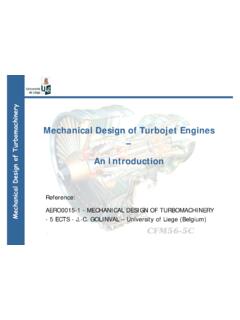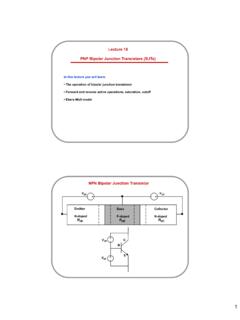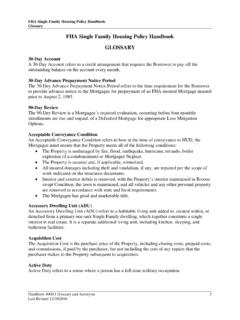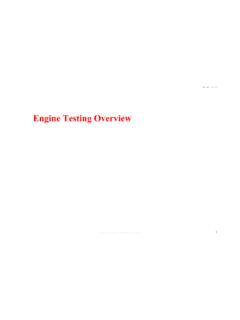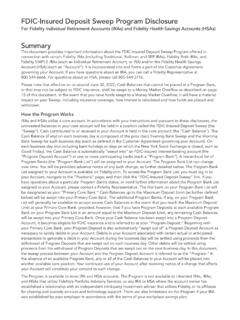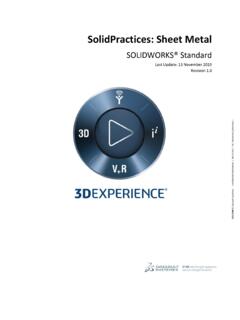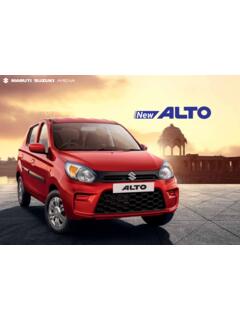Transcription of Fighter Aircraft Design - uliege.be
1 Fighter Aircraft designAerospace Design Project 2017- 2018G. DimitriadisGeneral configuration The elements of the general configuration are the following: Wing Wing placement Airfoil Number of engines Number and placement of engine air intakes Horizontal tail Canards Number of fins Other control surfacesWings Modern high performance fighters have one of three wing types: Trapezoidal Delta Sweptback with low aspect ratio Lower performance fighters (trainers, ground attack Aircraft etc) can also have high aspect ratio sweptback wings, just like transport Aircraft . Trapezoidal, Delta and low aspect ratio sweptback wings can fly at subsonic or supersonic speeds.
2 Such wings have low aspect ratios and are thin in order to minimize wave drag (drag due to shock waves). Aircraft with high aspect ratio sweptback wings cannot fly supersonic, except under special circumstances ( powered dives). Such wings have high aspect ratios and are thicker in order to accommodate a thick main waves All wings must lie inside the conical shock wave generated by the fuselage nose of an Aircraft flying at supersonic wings Advantages: Delta wings have a long root chord and therefore can have a thick main spar while retaining a low thickness- to- chord ratio. They also have larger wing area than trapezoidal wings with the same aspect ratio.
3 This means low wing loading even during maneuvers. There is a lot internal volume for fuel and landing gear. At low speed conditions they can produce a lot of additional lift when placed at high angle of attack, thanks to the leading edge vortices. Delta wing Aircraft do not require a horizontal tail. Disadvantages: Higher viscous drag due to the large wing area. High induced drag at subsonic conditions due to low aspect ratio. Bad deep stall. Pitch control is achieved by deflecting upwards the trailing edge control surfaces in order to produce a nose up moment. This reduces the total amount of lift generated by the wing.
4 This problem can be overcome by incorporating a horizontal tail or lifting with Delta wingsMiG- 21: Cropped Delta with tailEurofighter Typhoon: Cropped Delta with canardsMirage III, IV, V, 2000: Tailless cropped DeltaIAI Kfir: Upgraded Mirage V with canardsJAS 39 Gripen:Cropped Delta with canardsF- 102 Delta Dagger and F- 106 Delta Dart:Tailless cropped DeltaAircraft with Delta wings (2)Chengdu J- 10: Cropped Delta with canardsDassaultRafale: Cropped Delta with canardsSaab 35 Draken: Compound DeltaShenyang J- 8: Delta wing with tailSaab 37 Viggen: Compound Delta with canardsConcorde: Ogive DeltaMore on Delta wings The pitch control and bad deep stall disadvantages of Delta wings led to several variations: Compound Delta or Ogive Delta: the inboard sweep is generally higher so as to create even stronger leading edge vortices and delay stall to even higher angles.
5 Exception: Saab 37 Viggen. The Ogive Delta also reduces supersonic drag. Horizontal tail: Provides additionally stability in pitch and therefore the wing can produce more lift. Tail elevator provides pitch control Canards: They are usually all- moveable and provide additional pitch control. The Aircraft is usually statically unstable. Note also that flaps are difficult to use with a tailless Delta configuration. Delta wings are generally cropped. The pointy wingtip is difficult to manufacture and structurally weak. Furthermore, cropped Delta wings delay vortex bursting. The centreof lift lies aft on a Delta wing.
6 This means that the horizontal tail can only be effective if it lies even further aft. Usually the tail is highly swept and can be placed on a highly swept of some delta wing aircraftAircraftAspect RatioMaximum MachService CeilingRangeSea levelHigh altitudeMiG- ,400 ft1,470 kmEurofighter ,000 ft2,900 kmJAS- 39 ,000 ft1,600 kmMirage ,000 ft1,550 kmF- ,000 ft2,900 kmChengdu J- ,055 ft550 kmDassault ,000 ft1,852 kmSaab- 37 ,100 ft2,000 ,000 ft7,222 kmTrapezoidal wings In trapezoidal wings, the leading edge sweeps back but the trailing edge sweeps forward. Some Delta wings also feature a slight sweep forward angle at the trailing edge.
7 Advantages Better performance than Delta wings at transonic speeds and during transition to and from supersonic conditions. They do not require upwards deflection of the trailing edge control surfaces for pitch control and therefore do not lose lift. Their centreof lift lies further forward and therefore the tail must not lie too far back on the fuselage. They are preferred for stealth applications. Flaps can be easily used. Disadvantages: High wing loading. They stall at much lower angles of attack than Delta wings. This problem is overcome using Leading Edge (Root) eXtensions(LEX or LERX) and/or with trapezoidal wingsF- 18: Trapezoidal wing with tailF- 16: Trapezoidal wing with tailF- 22: Trapezoidal wing with tailSu- 57 (T- 50): Trapezoidal wing with tailF- 35: Trapezoidal wing with tailF- 104: Trapezoidal wing with T- tailSpecifications of some trapezoidal wing aircraftAircraftAspect RatioMaximum MachService CeilingRangeSea levelHigh altitudeF- ,000 ft2,017 kmF- 18 Super Hornet?
8 ? >50,000 ft2,346 kmF- >50,000 ft550 kmF- >65,000 ft2,960 km with external fuel tanksSu- ,000 ft3,500 kmF- ,000 ft2,200 kmF- ,000 ft1,600 kmMore on trapezoidal wings Trapezoidal wings are mostly used by the US. They are nearly always combined with a conventional horizontal tail and single or twin fin. They are nearly always combined with LEX. Some trapezoidal wings look like highly cropped Delta wings (F- 16 for example). Modern trapezoidal wings have very highly swept leading edges, approaching the sweep of Delta wings Both the leading and trailing edges are swept back. Sweptback wings have very similar characteristics to trapezoidal wings but have larger wing area.
9 Advantages: Higher wing area and hence lower wing loading. The centreof lift lies between that of trapezoidal and Delta wings. They have the trapezoidal wing advantages compared to Delta wings. Disadvantages: They require LEX, just like trapezoidal wings. They create higher viscous drag than trapezoidal with swept wingsMiG- 29, 35: swept wing with tailMiG- 25, 31: swept wing with tailMirage F1: swept wing with tailSu- 27, Su- 35: swept wing with tailSu- 30, Su- 34: swept wing with tail and canardF- 15: swept wing with tailSpecifications of some swept wing aircraftAircraftAspect RatioMaximum MachService CeilingRangeSea levelHigh altitudeMiG- ,100 ft1,430 kmMiG- 35?
10 ,340 ft2,000 kmMiG- ,915 ft1,730 kmMiG- ,600 ft3,000 km with external fuel tanksSu- ,523 ft3,530 kmSu- ,100 ft3,540 kmSu- ,800 ft3,000 kmSu- > ,200 ft1,100 kmMirage F1? ,600 ft1,400 kmSuper Etendard? ,900 ft2,000 kmF- ,000 ft1,967 kmMore on swept wings swept wings are mostly associated with the Soviet Design tradition. The leading edges of swept wings are highly swept , more than those of previous generation trapezoidal wings. All Aircraft with swept wings have a conventional but several modern Sukhoifighters also have canards. Most of these Aircraft are heavy fighters with two engines and twin aspect Ratio Statistical data from RaymerJet fighters and trainers have Aspect Ratios ranging from 4 to placement High- wing: Stable in roll and therefore anhedralis generally required to reduce stability.
